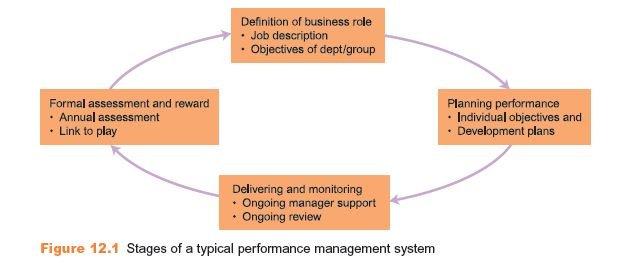Stages in a Performance Management System
In a performance management system, there are two options that are available. On the one hand is a reward driven option and on the other, there is a development driven option.
Business mission, values, objectives, and competencies
It is a common belief that before a particular company can go ahead with the management of individual performance rate, it needs to set the holistic approach to the company. So, the goals have to be set against the resources, aims and set targets of the company. Therefore, initially, a mission statement has to be set which can help in setting the correct targets so that it is placed within the overriding theme of the company.
According to Bevan and Thompson (1992), it can be said that organizations that concentrate specifically on concepts of performance management, are more likely to fulfill the mission of their company and can easily communicate this to the employees.
Also, there are many business organizations that specifically identify the strategic contexts that are associated with that company, and can associate that with competitive mission statement of that organization.
In other organizations, the process is continued as the concerned parties identify the key areas and values. Once that is done, it can be found that each of these core values has a particular role in management of company resources. Also, objectives of a particular organization are of prime importance, simply because the company’s objectives seep down to the employee’s objectives and therefore become their objectives on a wider note.
Planning performance: A shared view of expected performance
When the manager and employee come together for a joint meeting, the individual objectives to a great extent are derived from company’s joint objectives. The objectives associated include how individual functions, and offers potential development to the ever increasing needs of the business. For any organization is of primary importance if the priorities that are given highest authority and the ‘SMART’ technique is used.
The acronym can be specifically defined to target specific areas of these plans. They are Specific/Measurable/ Relevant/Timed and Appropriate.
In technical systems, it becomes easier to ensure that the concerned plan is followed since there is a system that is maintained. Ensuring that the staff can get their plans coordinated with that of the office, the objectives of an organization can easily be said to be a part of performance management system.
What is important is, after a certain point of time, the managerial position holders, as well as employees, should have a meeting to decide on the future courses of action.
Another very important point that you must follow while dealing with this process is having a ‘shared’ view of the whole context. When both the employees and managers viewpoints are taken into consideration, it can be found that the company can attain its objectives in a better manner. The ‘what’ and ‘how’ concepts have to be well understood, and only that can help in ensuring that the concerned objective is a common point to reach out.
Lets’ take an example. A particular manager has been assigned a job. To fulfill his work, he can either take help of other departments, since joint effort is allowed or can also force other departments to work on the concerned project. When the force is applied on respective departments, without considering their perspective of work, it can happen that the work is done in a shoddy manner and also the future relations could be spoiled.
However, when a collaborative approach is taken, the work is completed smoothly. In such a scenario, even the future projects can be dealt in a proper manner. To ensure that this whole process is carried out in the best manner, a correct planning with proper utilization of resources along with objectives is important.
When output targets are specified, it is important that objectives are restricted, and input targets are developed in a competitive manner. Also, it should be seen that the personal development plan is placed in a manner that it does not harm the company’s objectives in any manner.
Delivering and monitoring performance
The role of a particular employee is to work towards achieving his goal of fulfilling the objectives and ensuring that the company’s target is met. However, in this case as well, the manager holds the key position, and in case the process of meeting the target is not fulfilled, then the manager can very well change the position or revise the level of expected performance.
Now, if such a revision is required, it may so happen that the manager may be consulted by the employee for ways to proceed in that domain. In such a scenario, the manager, though there is requirement of, but still cannot share the ‘inside’ details of work, and ways to match the target. On the contrary, the manager provides ideas to the employee how the target can be achieved within a short span of time, can discuss and exchange ideas and finally provide constructive feedback to the employee.
Apart from that, the managers can help in charting out the path of success for the employees, discuss and provide ideas as to how successful people have reached at the top and determine potential role models that will ensure that the employee walks in the correct path to reach the topmost rung.
It is completely the employee’s responsibility to ensure that the target that has been set by the company should be met and company’s profits raised. But the manager has the consistent role of motivating the employee and provides him with all the resources for his benefit.
The concept of ongoing review is of prime importance for an employee, since it is this that determines the progress of an employee. The manager needs to be constantly updated on the employee’s progress to ensure that for further progress the best can be derived from the employee.
The primary function associated with this review process is to provide employees with a facility that would improve their future performance. The whole idea of putting forth ‘rewards’ is to provide employees with a motivation so that they can do well for themselves in future, and on an extension benefit the company.
To ensure that this whole review process goes well and employees to have no chance to complain, it is imperative that they must build up a portfolio that will help them to gather their positives before the company and place in regards to reviewing process. In due course of this action, the employee can collect the 360-degree feedback form for themselves that will help them to groom themselves in a better manner for developing better for the benefit of the company.
Formal performance review/assessment
The developmental issues in any company, when it comes to reaching the objectives are so high that employees need to have a detailed idea of the process. In most cases, they are given an opportunity by their company to prepare their draft of achievements that is placed against the company objectives. Finally, a comparative study is made an, therefore, employees can judge their position.
Another important point is, an annual assessment of these objectives and their fulfillment should be done to ensure that in future the company does not have to deal with such backlog problems. Even if it is done, the company can surely make proper use of its resources and employees to deal with it. The employees also get a chance to ensure that their level of progress is maintained.
The whole idea of the drafting of achievements was initially started off by Microsoft and AstraZeneca.
Another important point to note is views held by a number of organizations when it comes to providing employees the correct review. The managers at AstraZeneca are not allowed to provide overall rating to any employee. However, Institute for Employment Studies (IRS) 2001, believed that a fair review could only be stated when objectives are within achievable zone, and judgments regarding that particular employee have been consistent in that organization.
Reward
According to Fletcher and Williams (1992), this process has certain difficulties associated with it. According to them, in certain organizations, the base pay is so low that staff remains unmotivated and when the case study of that organization is considered, it is almost in a very negative zone.
The discussion with Mabey and Salaman (1995) is good when it comes to linking these performance concepts with that of payments associated. According to reviews provided by Institute for Employment Studies (IRS 2001), in comparison to monetary gains, if staff is provided timely leaves, promotion, and other facilities, then the whole process of getting good performance is enhanced to a great extent.
Window on Practice
AstraZeneca is one of those organizations, which has provided a number of approaches in regards to performance management. The ideal way to define performance management is to agree upon a set of objectives, reviewing whether the objectives that are placed are fulfilled, and performance being reviewed at the end (with answers to queries as ‘why’ and ‘how’).
There are 4 principles that have to be taken care of in this case. Scroll down:
- Joint Responsibility
Since everyone is aware of their respective job roles, therefore there is no chance that they will not be able to match up the targets. The prime idea of this process is to provide all the workers, whatever be their status with a common objective where they would have to jointly frame it. It is entirely the duty of managers to ensure that in case of any crucial situation, the managers would completely allow the workers to take up risks, innovate and place them into the challenge that lies ahead.
As a team, the various segments of the office have to work in an aligned manner to ensure that the challenge that comes ahead is fulfilled and the company is in no way harmed. This is one of the most important points of AstraZeneca that it is concerned with when it comes to performance management.
- Aligned Objectives
The best part of AstraZeneca is that they work towards a common goal. The managers, leaders, and workers all have the same goal, and each of them is aware of their responsibilities. It is the duty of the manager to ensure that the workers know their work, their strength and weakness and can work it out accordingly. The annual review of delivery against objectives is put to the forefront, and every individual of the organization works towards a common goal.
Thus, their performance can be reviewed on an annual basis.
- Rewarding Performances
The principles of Global remuneration and performance management are given highest authority in AstraZeneca. Therefore the managers and leaders will provide ideas regarding responsibilities of rewards and how performance can be managed in an ideal manner.
- Constructive Exchange of ideas
The employees, project manager, and team leaders need to have an honest conversation amongst them to ensure maximum profits for the company and matching up of targets. It may so happen that a particular employee may not reach up to the given standards. In such a case, they need to talk it out with seniors, and calculate areas where they can improve, so that such occurrences do not happen in future.
All these aspects have to be taken into account to get performance management reports. It is based on this that, AstraZeneca can deliver rewards accordingly.
Implementation and critique of performance management
The main idea of performance management is its idea of being line driven and not HR driven. In any organization, the presence of a line manager is necessary, since every segment is guided by how the line is managed. So the introduction of HR management with line management, demonstrates how the particular line is led.
According to Fletcher and Williams (1992), there is the concept of grooming line managers as ‘performance management coach,’ who were an important part of developmental training as well as support of the newly developed system.
According to Bevan and Thompson (1992), stated that performance management systems are adopted with certain aspects. The alignment is critical since it is based on this that the final line management is done.
However, if seen from a neutral perspective, the performance management system has its own backlogs that are similar to traditional appraisal methods. The whole idea of using ratings in performance management system is seen by many as a matter of demotivation. The employees do not hold very positive reviews regarding this process, and hence managers also did not receive ideal training in performance management. Hence the marking scheme, even if placed on an average can go wrong.
When individual objective is taken into consideration, it can be found that SMART targets, if not executed in a proper manner can result in problems. There are a number of previously set objectives that have to be taken care of as well. But what is most important in all of this is what the employee’s joint contribution is and how their joint help can result in taking the company to higher levels.
Also, in most cases when the SMART technique is used, it is primarily the short term goals that are considered. But the company when dealing with developmental procedures, may not be able to match up the demands of SMART objectives. The development of competency will also result in getting to add a greater value to the company. This range of competencies depends within the domain of ‘how’ and ‘what’ and hence to describe performance of a company and its success, a detailed analysis of all these prospects are a must.
Links of Previous Main Topic:-
- Selection methods and decisions
- Staff retention
- Ending the contract
- Strategic aspects of performance
- Organisational performance
- Individual performance management
Links of Next HR Management Topics:-
























